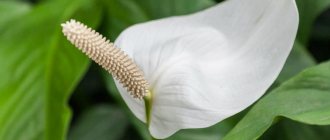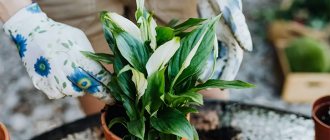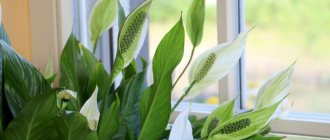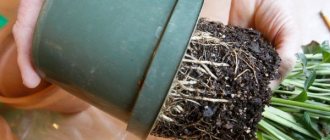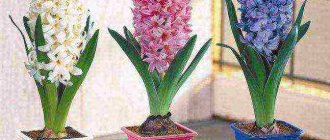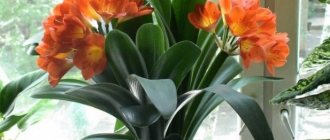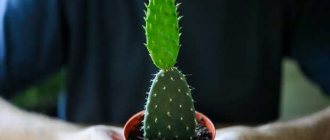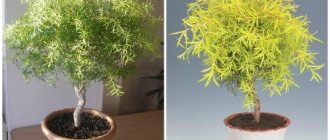Reproduction
The secret of success in propagating spathiphyllum depends on the choice of its method. The most labor-intensive method, which also does not guarantee the growth of a young individual, is to propagate using seeds. There are three known methods of reproduction:
- seed germination;
- dividing the bush;
- rooting cuttings.
Germination of seeds
Important! The germination of spathiphyllum seeds strongly depends on their freshness
When purchasing planting material, you should pay attention to the date of their collection.
Experienced gardeners prefer to collect the seeds themselves, which increases the likelihood of germination. To obtain seeds, it is necessary to artificially pollinate flowers.
Procedure for germinating seeds:
- Pour steamed substrate from a mixture of sand and peat into the planting container;
- The soil should be slightly moist. The seeds are sown and slightly pressed in or sprinkled with a little soil on top;
- The container is covered with film and placed in a warm place at a temperature of about 25°C. It is necessary to ensure that the soil does not dry out, moistening it periodically;
Important! The ground under the film should be ventilated daily
- After the sprouts appear, the film is removed on the 5-7th day;
- When the sprouts have thrown out their first leaves, they can be transplanted into separate pots.
Rooting cuttings
Next to the mature leaves, young leaves sprout from the ground. They will become cuttings when separated and pulled out of the soil. The separation is carried out with a sharp cutting instrument, which is pre-disinfected. The movement of the knife should be quick and short.
Sometimes cuttings do not have roots. Then they are kept in water until roots appear. The cuttings with roots should be planted in soil previously heated in the oven. A drainage layer is placed at the bottom of the flower container.
Planting cuttings of spathiphyllum
The pot with the plant is placed in a warm (temperature exceeds 21°C), slightly shaded place
One or two days after planting, you can only spray the sprout, then carefully begin watering, keeping the soil moist, but without excess water.
Dividing the bush
Is the most successful method. As the plant ages, it forms a strong rhizome that can be divided with a sharp knife. Each part must contain at least 3 sheets forming a rosette. Rotten roots are cut off.
Dividing the rhizome of spathiphyllum
The cut areas are treated with coal. Individual parts are planted in pots and watered vigorously. During the first three months of growth, they are not fertilized.
Important! To maintain the strength of the plant, it is advisable to divide it every 3-4 years, combining it with transplants
Why is a houseplant without flowers reasons?
When flowering, the plant produces a bud on a long stem (40-50 cm).
The inflorescence resembles an ear. The beauty of the flower is given by the white leaves covering the cob. Over time, they turn green and turn into regular leaves. Usually the plant blooms in the spring, but if the maintenance conditions are met, it can bloom 2 times a year. Sometimes homemade spathiphyllum grows, forms a fluffy bush, but does not produce flowers. It is necessary to check the conditions of its maintenance, make sure it is properly cared for, increase the humidity, ensure regular watering 2 times a week and fertilization.
If all conditions are met correctly, you can move the plant to another location. Preferably with an influx of fresh air (not in winter). Low temperatures at night stimulate flowering. The flower will not bloom if the pot is chosen incorrectly. The potty requirements are described above. If this condition is not met, a transplant must be performed.
Spathiphyllum can be induced to flower by subjecting it to stress. To do this, do not water for several days. Then transfer to a cool place for 2-3 days. Then put the flower in its original place, continuing normal care, and wait for flowering.
Features of reproduction at home
This representative of the Araceae is somewhat poisonous and can cause allergies. When handling it you need to be wary of dermatitis. But it does not emit harmful substances into the air. On the contrary, it perfectly cleanses the environment. To create this effect, there should be about 7 copies in one room.
Growing spathiphyllum
Getting extra plants is not a problem. Those who like this culture can reproduce an existing specimen of spathiphyllum. Even novice home botanists can handle the simple action.
In order for the procedure to be successful, you must follow the rules. Having noticed good growth, the gardener is interested in how to propagate spathiphyllum at home.
Three types of planting material are obtained from an adult specimen:
- seeds;
- cuttings;
- parts of the bush for division.
People who liked spathiphyllum in the house decide to expand the plantation
It is important to avoid a number of common mistakes. The most popular propagation methods are using cuttings or dividing rhizomes.
The seeds of indoor spathiphyllum are also used and sowed. This method is less common due to a number of difficulties.
A special feature of plant care is the need for regular replanting. It is advisable to use this process for simultaneous reproduction.
Step-by-step guide to propagation from cuttings
The success of vegetative propagation is very likely; it applies to almost all representatives of the flora
Dividing a bush is a simple process that must be done with caution. The secret of the growing season is that the formation of “babies” at the base allows for successful planting
The rosette of leaves has small roots; in the spring they easily separate.
It's time to replant the spathiphyllum
Sequencing:
- It is necessary to inspect and find vegetative material (rosettes, shoots).
- Small sprouts that emerge from the soil are up to 3 cm in size. If they are not separated, they will increase in size and form a new large rosette. Using a sharp knife, they are cut off along the connecting root in one movement.
- The offspring is taken out, examined to see if there are roots, and then planted in the ground. Usually they make a greenhouse or greenhouse for adaptation. If there is no root system, it can be pre-grown in a container with water.
Attention! It is recommended to wipe the knife with alcohol against fungi
From the stems
The method of how to propagate spathiphyllum by cuttings and how to take a shoot is not the only one possible during the growing season. The indoor flower is also subjected to rhizome division.
Step by step method:
- The spring period is selected simultaneously with the necessary transplantation.
- The rhizome is cut with a sharp knife. The sections are sprinkled with charcoal (not activated) charcoal.
- Separate stems are obtained, which are planted under a transparent cap.
Root divisions take root in almost every case, but only experienced gardeners carry out the procedure correctly. There is a very high risk of spoiling the original plant.
From leaves
Propagation of spathiphyllum by leaves like begonias is impossible. Simply lowered into water or buried in the ground, it does not give roots and dies. Therefore, the method does not apply to this crop.
How to germinate spathiphyllum shoots in water
Rosettes with leaves and small roots can be kept in a container of water. Over time, the root system will grow.
Dividing a spathiphyllum bush
The flower is planted in a separate container and the necessary conditions for watering, temperature (about 22 degrees), and lighting are created.
Instructions for growing from seeds
The seed propagation method is not reliable. In most cases, success is not achieved. This is considered possible according to theory:
- Artificial pollination will be required, which not everyone can do at home.
- Low germination rate, especially it decreases over time. There is hope only with immediate sowing.
- A soil made of peat and sand does not guarantee optimal conditions of humidity and ventilation, even if a greenhouse is created.
For all these reasons, it is easier for a gardener to propagate the crop by vegetative methods.
Leaf planting
Sooner or later you will want to increase your plantation of these beautiful plants. First of all, we will warn those who have not grown spathiphyllum before from making mistakes. It cannot reproduce by leaf.
We invite you to familiarize yourself with Melamine sponge - “Cinderella was lazy and died early (photos BEFORE and AFTER cleaning tiles, cabinets and sinks with a melamine sponge)”
Unlike, for example, begonia, a spathiphyllum leaf dipped in water will simply rot without giving roots. The same thing will happen if you immediately stick it into the ground, as is done with many succulents. Flower growers practice propagation of spathiphyllum by cuttings or division of rhizomes.
It is, of course, possible to use seeds, but it is complicated by many factors, which will be discussed below.
Dangerous “fans” of spathiphyllum
Low susceptibility to infections is another advantage that spathiphyllum will delight. Diseases common among other indoor plants affect it extremely rarely. However, there is no escape from pests! Spider mites, aphids, mealybugs and scale insects are dangerous for spathiphyllum.
And here it is important to determine in time who “visited” you and take measures to save your pet. A weightless web appeared on the flower, and the leaves began to dry out? This is a spider mite
Carefully collect all the threads and wash the leaves with soapy water, onion peel tincture, and treat with ground sulfur or purchased insecticides. The main thing is to rinse the poor thing with clean warm water afterwards. Are the leaves curling, withering and drying out? Your guest is an aphid. It breeds incredibly quickly, so you need to act quickly. Nicotine sulfate is your weapon! Just cover the ground with polyethylene, and be prepared to attack repeatedly: you won’t get the aphids out the first time. The scale leaves behind dark spots throughout the body of the plant. Tobacco-soap solution will help you! Wipe only stains; healthy areas can be left untouched. And again wash the flower after processing.
Mealybugs can also be identified visually; there is no need to look for any signs. Excess humidity contributes to its appearance; upon examination it is easily detected. If there are few pests, simply wipe the leaves with a rag soaked in alcohol. In case of serious infection, you will have to resort to chemicals.
Cuttings
Vegetative methods are applicable to almost any plant - some more, others less. Spathiphyllum is no exception. Reproduction by dividing the bush is most popular due to the relative simplicity of the process. At the base of an adult plant, “babies” are formed - a small leaf rosette with bent roots.
In the spring, when it is time to transplant, they are carefully separated from the mother plant. The main thing in this process is to untangle the roots, being careful not to tear them off.
The cuttings are rooted in soaked sand or perlite. Reproduction of spathiphyllum will occur without problems if each new bush is covered with a transparent cap, preferably with holes. If they are missing and cannot be done, you will have to ventilate the plantings two or three times a day. When the root system grows and becomes stronger, the planted plants are moved to a substrate prepared in the manner already described.
Spathiphyllum: how to grow “female happiness” at home (INFOGRAPHICS)
Breeders have not ignored this flower and, as a result, a huge variety of spathiphyllum varieties on the shelves of flower shops. Dutch flower growers have especially tried here, as they export this plant, and very successfully
This plant is classified into five groups:
- Hydnostachyon Liebm.
- Massovia C.Koch. Includes Spathiphyllum cannofolia.
- Spathiphyllopsis Teijsm. & Binn.
- Amomophyllum Engl. Includes the species Spathiphyllum profusely flowering.
- Spathiphyllum Schott in Schott & Endl. Includes Spathiphyllum charming, Spathiphyllum spoon-shaped and Spathiphyllum Wallis. It is also used as an international scientific name.
Let's look at the most cultivated varieties:
This species is distinguished by the fact that it has a creeping stem, on which up to 40 leaves can be located at the same time. Other species do not have stems at all; the leaves grow from the roots, forming a bunch.
- Height from 50 to 60 centimeters.
- The leaves are lanceolate-oval, leaf length 15–20 centimeters, width 9–12 centimeters.
- The height of the flower is 10–12 centimeters.
- Peduncle 25 centimeters.
It is also called Royal. The flower has some differences from the flowers of other species. The inflorescence is initially yellowish, and towards the end of flowering it turns black. The bedspread does not change color. It is twice as long and wider than the inflorescence, the shape is slightly concave, and looks like a sail filled with wind.
- Height 100 centimeters.
- The leaf is oblong, glossy, dark green, wavy along the edge, width 15–20 centimeters, length 30–40 centimeters.
- The inflorescence is white.
- The shape of the bedspread is oval.
The most undemanding among spathiphyllums. Flower growers even grow it in an aquarium, but in such an environment it grows very slowly. It can stay in the aquarium for only a few months, then it needs to be transplanted and returned to its previous way of life, this time out of water.
• Height 25 centimeters. • The flower is white, the shape is narrow and long, three times larger than the spadix. • The leaf is dark green.
• The inflorescence is white, turning green towards the end of flowering.
This species is the most beloved by breeders; it has about 40 varieties. These include the following well-known varieties: “Chopin” (Chopin), “Mozart”, “Sweet Silvio”, “Cupido”, “Sweet Pablo”, “Sweet Benito”, “Sweet Lauretta”, “Sensation”, “Picasso” , “Domino”, “Sweet Chico”, “Bellini”, “Strauss”. The height of these plants is from 30 to 70 centimeters. And the variety of colors and shapes complicates the selection process; you want to buy everything at once.
There are also miniature varieties of spathiphyllum. Their names are also no less famous: “Quatro”, “Tango”, “Alana” and the result of Thai breeders “New one”.
Tall spathiphyllum hybrids also look very impressive, these include: “Sensation”, “Giant”.
When shopping, pay attention to those suppliers who harden off their plants before putting them on store shelves. After hardening, it will be easier for the plant to cope with the stress of changing its place of residence, and it will be better to acclimatize to new environmental conditions.
Your apartment for a plant is nothing more than a new and unknown environment, and it is not always adapted to a particular indoor plant
After hardening, it will be easier for the plant to cope with the stress of changing its place of residence, and it will be better to acclimatize to new environmental conditions. Your plant apartment is nothing more than a new and unknown environment, and it is not always adapted to a particular indoor plant.
general description
The oval leaves of the plant with a pointed end grow from the ground; many species lack a stem. Cuttings with foliage from 15 cm to 1.5 m in height grow from the rhizome. The purpose of spring flowering is to attract insects for pollination and seed development. Sometimes the process is observed repeatedly throughout the year. In the plant world of the tropics and subtropics, spathiphyllum is located on the lower tier. He has no tolerance to bright sunlight. In its complete absence, the flowering period may be halved.
Spathiphyllum in its natural habitat
The plant does well in the shade and prefers diffused light. When bright direct rays fall on it, the leaves fade and dry out. Based on this pattern, a north, west or east window is chosen to place the crop in the house.
Spathiphyllum appeared in Europe towards the end of the 19th century, when it was brought from the jungles of America. The discoverer is considered to be the German researcher G. Wallis, after whom one of the varieties is named.
Preparation for the propagation procedure (equipment, soil, container)
Before propagating spathiphyllum, prepare the necessary items and tools:
- sharpened, disinfected scissors, knife, pruning shears;
- ceramic or wooden containers;
- containers under water for temporary maintenance of cuttings;
- film or glass for organizing a mini-greenhouse.
The land for planting should be light and fertile. You can buy ready-made soil for flower crops or prepare it yourself. In the second case you will need:
- garden soil;
- peat or humus;
- small pieces of pine bark;
- charcoal;
- a little sand.
Young seedlings need containers that are not too large, otherwise they may not bloom. Spathiphyllum does not bloom until its roots entwine the entire space of the pot.
Note! Containers must have drain holes and a drainage pad made of expanded clay or pebbles. The drainage layer is sprinkled with sand on top
Further care for sprouts and young plants
Young spathiphyllum seedlings first need care. Even tall plants that have just been transferred to a new pot are covered with a plastic bag to maintain moist air under the hood.
Mini greenhouse made from a plastic bottle
Basic rules for flower care:
- Every day and more than once a day, the shelter is raised, condensation is removed and the leaves are sprayed.
- The lighting should be bright, but soft and long. Leaves will get burned from direct sunlight.
- The thermometer in the room should not fall below +25 °C.
- Water the flower when the soil surface dries. At the same time, they are regularly sprayed to keep the air moist.
Note! The flower is not watered immediately after planting.
At first glance, it may seem that growing a flower is a difficult task and difficult to care for. But experienced flower growers claim that if all the subtleties are observed, caring for the plant is not a burden.
Reproduction of spathiphyllum
We discussed the intricacies of caring for the hero of the article. Let's consider the propagation of spathiphyllum. This procedure is simple.
Method one - cuttings
Vegetative propagation methods are applicable to many plants, including dieffenbachia, croton, dracaena and spathiphyllum. This is the most popular method of propagating spathiphyllum due to its simplicity.
- At the base of a full-fledged plant, “babies” appear, which are a leaf rosette with roots. When spring comes, carefully separate them. The main thing is that the roots do not break. To root the resulting cuttings, use perlite or damp sand.
- To ensure that spathiphyllum propagates without trouble, be sure to cover the new bush with a perforated transparent cap. Otherwise, the cutting will have to be ventilated.
- As soon as the root system gets stronger and grows, move the young plant into the ground. I talked about the composition of the substrate at the beginning of the article. Provide the flower with standard care.
Method two - dividing the rhizome
Spathiphyllum can also be propagated in a way that involves dividing the root system. This approach ensures 100% survival rate. However, inept actions of a beginner can lead to the death of the mother plant. For this reason, experienced gardeners resort to this method.
- The operation of dividing the rhizome is carried out in the spring. This time is best for transplantation procedures.
- Using a sharp knife, carefully divide the rhizome into parts, and treat the sections with charcoal. Subsequent steps are similar to propagation by cuttings.
Method three - propagation by seeds
You can also get a young spathiphyllum plant using seeds, but this is an unreliable method. Practice shows that it is possible to propagate a plant at home using seed material, but not every attempt ends in success.
- It is necessary to artificially pollinate the flowers, which is not always possible. The seeds are characterized by low germination and it is problematic to obtain sprouts.
- I recommend sowing seed material in a container with a sand-peat mixture, which must be covered with a piece of glass. Control air humidity and ventilate the sprouts, otherwise they will suffocate. It is easier to propagate spathiphyllum vegetatively.
Interesting fact: it is impossible to propagate spathiphyllum by rooting a leaf. If you put a leaf in a container of water, it will not grow roots and will rot. It will end the same way if you stick a leaf into the soil. Since the seed material is not very suitable for this purpose, it is better to propagate by cuttings or by dividing the root.
Dividing the bush
This method of reproduction is convenient and easy to implement. It is also useful for an adult plant, as it is an opportunity to “thin out” a dense bush. The flower grows quite quickly, and the young rosettes remove all nutritional components from the soil, depriving the mother plant.
IMPORTANT: Dividing the bush has a positive effect on the subsequent growth and development of spathiphyllum.
Divide the bush early in the spring, even before the start of the growing season. The root system should be strong and without injury. The delenka is ready to grow on its own if it has 3 leaf rosettes that are well developed. The root collar of immature plants should be at the same soil level as that of the mother bush.
The container for the flower should be small in volume, since in a deep container the root system will begin to actively develop, and this will lead to rapid growth of leaves and delayed flowering.
Procedure:
- Before the procedure, water the mother plant in the flower pot generously. This will make it easy to remove the flower with a lump of earth and less trauma to the root system.
- As soon as the flower has been removed from the container, its roots are thoroughly washed from the soil and, if possible, untangled.
- The prepared root system will be easier to separate.
- Sprinkle the cut areas on the root system with finely tuned activated carbon. Wait 2-3 hours for them to dry.
- Before planting each division, perform a careful inspection and remove dried and rotten parts from the root system and leaves.
- Plant each young plant in a shallow and narrow container.
- Spread the fragile roots over the surface of the soil and carefully sprinkle with nutrient substrate. After this, compact it slightly.
To plant cuttings, you need to buy ready-made soil for plants of the Araceae family or prepare it yourself. To do this, connect the following components:
- leaf soil - 1 part;
- peat – 1 part;
- turf – 1 part;
- river sand – ½ part.
Watch a video about propagation by dividing the bush:
FAQ
Why replant the plant every year?
This must be done so that the plant blooms profusely in the summer. In this case, the pot must be exactly the size of the spathiphyllum root system.
Why remove dead parts of the plant when dividing the rhizome?
They are removed because there may be infections in their sinuses and this will be visible when removed. Also, when they decompose, they can cause harm to the plant, and what is important is the appearance of the plant. Decomposed and dry parts of the leaves will not add beauty to it.
What do the brown edges of the spathiphyllum leaf mass indicate?
This indicates that the air in the room is very dry. This can be corrected by placing the container with the plant in a wide tray on expanded clay. The brown tips will not turn green, but it will stop them from appearing en masse on the bush.
Depending on flowering: before, during flowering and after
The main flowering period for spathiphyllum is from March to September. In winter, the plant blooms rarely, gaining strength. Young individuals begin to bloom in the second year of life.
Before flowering, fertilizing is used in the form of preparations with potassium and phosphorus.
During this period, it is important to maintain the normal immunity of the flower, strengthening its protective function.
During flowering, it is necessary to provide the plant with warmth; do not take the flower pot outside and avoid drafts. Blooming spathiphyllum cannot be replanted.
After flowering ends, the plant is prepared for hibernation.
The flower is removed from all the old peduncles, leaving 2-3 cm from the rhizome. The plant is moved to a cool place and the watering and spraying regime is changed up to twice a week.
Seed method: instructions for advanced
Spathiphyllum flowers are bisexual, they have both pistils and stamens. To obtain seeds, the flower must be pollinated. At home, this is very difficult, since the maturation periods of female and male specimens do not coincide.
Seeds are obtained in greenhouses where there are many plants. A pollinated female flower can be distinguished by its appearance - it turns green and becomes voluminous from the developing seeds. The ripening period is about six months.
Ripe seeds quickly lose their viability; they must be sown immediately after harvesting.
If you buy seeds at a flower shop, pay attention to the expiration date. Even fresh planting material does not guarantee one hundred percent germination.
Seed planting procedure:
- Place a layer of drainage at the bottom of the container, and disinfected loose nutrient soil on top of it.
- Place the seeds 3-4 cm apart and lightly press them into the moist soil.
- Cover the container with clear glass.
- Keep the container with seeds in a warm room at a temperature of at least 25 °C.
- Water the seedlings if necessary, and regularly ventilate the greenhouse to get rid of condensation.
When two pairs of true leaves appear on the seedlings, their growth reaches 5 cm, plant the seedlings in separate containers. Keep young specimens in a warm, well-lit place, but away from drafts and direct ultraviolet rays.
The most suitable time for transplanting and propagating spathiphyllum is spring. It is necessary to carry out these procedures before flowering begins.
Location
Any corner of your home is suitable for growing Spathiphyllum. Only on the south side near the window will it have to be protected from direct sunlight. A flower illuminated by constantly scattered rays of the sun will grow better, bloom more abundantly and more colorfully. On the north side of the house it will be good at any time of the year, provided that the windows face directly onto the street and not onto a loggia or a tall tree in front of the window. Otherwise, it will bloom more modestly here, grow less quickly and is unlikely to reach large sizes, even with artificial lighting.
In winter, it is better to move the flower to a south window, as it needs a lot of light. In the summer, many flowers love to live in the fresh air - on the balcony, in the garden. But not all types of Spathiphyllum. They do not like sudden temperature fluctuations or climate change. It is better not to take such flowers out into the fresh air so that they do not get sick.
Seed method: instructions for advanced
Spathiphyllum flowers are bisexual, they have both pistils and stamens. To obtain seeds, the flower must be pollinated. At home, this is very difficult, since the maturation periods of female and male specimens do not coincide.
Seeds are obtained in greenhouses where there are many plants. A pollinated female flower can be distinguished by its appearance - it turns green and becomes voluminous from the developing seeds. The ripening period is about six months.
Ripe seeds quickly lose their viability; they must be sown immediately after harvesting.
If you buy seeds at a flower shop, pay attention to the expiration date. Even fresh planting material does not guarantee one hundred percent germination.
Seed planting procedure:
- Place a layer of drainage at the bottom of the container, and disinfected loose nutrient soil on top of it.
- Place the seeds 3-4 cm apart and lightly press them into the moist soil.
- Cover the container with clear glass.
- Keep the container with seeds in a warm room at a temperature of at least 25 °C.
- Water the seedlings if necessary, and regularly ventilate the greenhouse to get rid of condensation.
When two pairs of true leaves appear on the seedlings and their growth reaches 5 cm, plant the seedlings in separate containers. Keep young specimens in a warm, well-lit place, but away from drafts and direct ultraviolet rays.
The most suitable time for transplanting and propagating spathiphyllum is spring. It is necessary to carry out these procedures before flowering begins.
